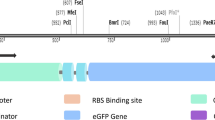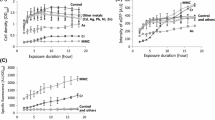Abstract
Although luminescent bacteria-based bioluminescence inhibition assay has been widely used in the toxicity assessment of environmental pollutants, the response of a luminescent bacterium usually lacks specificity to a target analyte. Recently, some specific analyte inductive promoters were fused to the lux genes for the purpose of selective bioluminescent sensing, and suits of specific promoters were fused to lux genes to compose a bioluminescent array sensor for simultaneous identification of multiple analytes. However, specific promoter-based methods still suffer from drawbacks including limited selectivity, slow responding time, expensive to construct different promoters involved plasmids, and laborious to find new promoters. Herein, we proposed a novel strategy to construct a lux reporter array sensor by directly transforming the natural lux genes in different bacterial hosts without the involvement of any specific promoters. Due to the distinct pathways of signal production, the responding time of the current different bacterial host (DBH)-based lux reporter array has nearly an order of magnitude faster than with specific promoter-based methods. The DBH-based lux reporter array was successfully used for simultaneous identification, quantification, and toxicity/bioactivity assessment of multiple metal ions. Obviously, all the chemical synthetic material-based metal ion sensing methods cannot simultaneously achieve analysis and toxicity evaluation. This approach possessed additional advantages of facile construction, easy operation, high selectivity, fast response, and strong adaptability to other analytes.
Graphical abstract

A different bacterial host-based lux reporter array was established for simultaneous analysis and toxicity assessment of multiple metal ions.





Similar content being viewed by others
References
Meighen EA. Molecular biology of bacterial bioluminescence. Mol Biol Rev. 1991;55(1):123–42.
Widder EA. Bioluminescence in the ocean: origins of biological, chemical, and ecological diversity. Science. 2010;328(5979):704–8.
Jafari M, Keshavarz MH, Salek H. A simple method for assessing chemical toxicity of ionic liquids on Vibrio fischeri through the structure of cations with specific anions. Ecotox Environ Safe. 2019;182:109429.
Abbas M, Adil M, Ehtisham-ul-Haque S, Munir B, Yameen M, Ghaffar A, et al. Vibrio fischeri bioluminescence inhibition assay for ecotoxicity assessment: a review. Sci Total Environ. 2018;626:1295–309.
ISO, 11348-1:2007, Water quality—determination of the inhibitory effect of water samples on the light emission of Vibrio fisceri (luminescent bacteria test)—part 1: method using freshly prepared bacteria. International Organization for Standardization; 2007.
Jones D, Scarlett AG, West CE, Rowland SJ. Toxicity of individual naphthenic acids to Vibrio fischeri. Environ Sci Technol. 2011;45(22):9776–82.
Zito P, Podgorski DC, Johnson JT, Chen H, Rodgers RP, Guillemette F, et al. Molecular-level composition and acute toxicity of photosolubilized petrogenic carbon. Environ Sci Technol. 2019;53(14):8235–43.
Aammi S, Karaca F, Petek M. A toxicological and geno-toxicological indexing study of ambient aerosols (PM2.5-10) using in vitro bioassays. Chemosphere. 2017;174:490–8.
Baldwin TO, Berends T, Bunch TA, Holzman TF, Rausch SK, Shamansky L, et al. Cloning of the luciferase structural genes from Vibrio harveyi and expression of bioluminescence in Escherichia coli. Biochemistry. 1984;23(16):3663–7.
Smolander OP, Ribeiro AS, Yli-Harja O, Karp M. Identification of β-lactam antibiotics using bioluminescent Escherichia coli and a support vector machine classifier algorithm. Sens Actuator B-Chem. 2009;141(2):604–9.
Bondarenko O, Ivask A, Käkinen A, Kahru A. Sub-toxic effects of CuO nanoparticles on bacteria: kinetics, role of Cu ions and possible mechanisms of action. Environ Pollut. 2012;169:81–9.
Niazi JH, Kim BC, Ahn JM, Gu MB. A novel bioluminescent bacterial biosensor using the highly specific oxidative stress-inducible pgi gene. Biosens Bioelectron. 2008;24(4):670–5.
Yagur-Kroll S, Amiel E, Rosen R, Belkin S. Detection of 2,4-dinitrotoluene and 2,4,6-trinitrotoluene by an Escherichia coli bioreporter: performance enhancement by directed evolution. Appl Microbiol Biotechnol. 2015;99:7177–88.
Sun Y, Zhao X, Zhang D, Ding A, Chen C, Huang WE, et al. New naphthalene whole-cell bioreporter for measuring and assessing naphthalene in polycyclic aromatic hydrocarbons contaminated site. Chemosphere. 2017;186:510–8.
Durand MJ, Hua A, Jouanneau S, Cregut M, Thouand G. Detection of metal and organometallic compounds with bioluminescent bacterial bioassays. Adv Biochem Eng Biotechnol. 2016;154:77–99.
Chandrangsu P, Rensing C, Helmann JD. Metal homeostasis and resistance in bacteria. Nat Rev Microbiol. 2017;15:338–50.
Jouanneau S, Durand MJ, Courcoux P, Blusseau T, Thouand G. Improvement of the identification of four heavy metals in environmental samples by using predictive decision tree models coupled with a set of five bioluminescent bacteria. Environ Sci Technol. 2011;45(7):2925–31.
Melamed S, Lalush C, Elad T, Yagur-Kroll S, Belkin S, Pedahzur R. A bacterial reporter panel for the detection and classification of antibiotic substances. Microb Biotechnol. 2012;5(4):536–48.
Elad T, Seo HB, Belkin S, Gu MB. High-throughput prescreening of pharmaceuticals using a genome-wide bacterial bioreporter array. Biosens Bioelectron. 2015;68:699–704.
Ivask A, Rõlova T, Kahru A. A suite of recombinant luminescent bacterial strains for the quantification of bioavailable heavy metals and toxicity testing. BMC Biotechnol. 2009;41:1–15.
Nriagu JO. A history of global metal pollution. Science. 1996;272(5259):223–4.
Yuen LH, Franzini RM, Wang S, Crisalli P, Singh V, Jiang W, et al. Pattern-based detection of toxic metals in surface water with DNA polyfluorophores. Angew Chem Int Ed. 2014;53(21):5361–5.
Shui Z, Li JW, Yang P, Huo DQ, Hou CJ, Shen CH. Amino acid-modulating gold nanoparticle sensor array: an express metal ion recognition system. Anal Methods. 2019;11:5691–8.
Yin H, Truskewycz A, Cole IS. Quantum dot (QD)-based probes for multiplexed determination of heavy metal ions. Microchim Acta. 2020;187:336.
Li YX, Hou JZ, Zhou HP, Jia MQ, Chen SS, Huang H, et al. A fluorescence sensor array based on perylene probe monomer-excimer emission transition for the highly efficient differential sensing of metal ions and drinking waters. Sens. Actuator B-Chem. 2020;319(15):128212.
Cao ZY, Fan X, Yang ZY, Zhang XB, Ding NXJ, Ding YB, et al. Solvent directed discrimination of metal ions using a coumarin-pyridine fluorescence receptor. Sens Actuator B-Chem. 2020;310(1):127855.
Feng CY, Zhao P, Wang LL, Yang T, Wu YS, Ding Y, et al. Fluorescent electronic tongue based on soluble conjugated polymeric nanoparticles for the discrimination of heavy metal ions in aqueous solution. Polym Chem. 2019;10:2256–62.
Song C, Zhao Z, Lin YH, Zhao Y, Liu XY, Lin CX, et al. A nanoneedle-based reactional wettability variation sensor array for on-site detection of metal ions with a smartphone. J Colloid Interface Sci. 2019;547(1):330–8.
Bryksin AV, Matsumura I. Rational design of a plasmid origin that replicates efficiently in both gram-positive and gram-negative bacteria. PLoS One. 2010;5:e13244.
Yoon KY, Byeon JH, Park JH, Hwang J. Susceptibility constants of Escherichia coli and Bacillus subtilis to silver and copper nanoparticles. Sci Total Environ. 2007;373:572–5.
Fowler L, Janson O, Engqvist H, Norgren S, Öhman-Mägi C. Antibacterial investigation of titanium-copper alloys using luminescent Staphylococcus Epidermidis in a direct contact test. Mater Sci Eng C-Mater Biol Appl. 2019;97:707–14.
Quang DT, Kim JS. Fluoro- and chromogenic chemodosimeters for heavy metal ion detection in solution and biospecimens. Chem Rev. 2010;110(10):6280–301.
Yu Z, Zhang J, Hou M. The time-dependent stimulation of sodium halide salts on redox reactants, energy supply and luminescence in Vibrio fischeri. J Hazard Mater. 2018;342:429–35.
Nicolini V, Gambuzzi E, Malavasi G, Menabue L, Menziani MC, Lusvardi G, et al. Evidence of catalase mimetic activity in Ce3+/Ce4+ doped bioactive glasses. J Phys Chem B. 2015;119(10):4009–19.
Farag MM, Al-Rashidy ZM, Ahmed MM. In vitro drug release behavior of Ce-doped nano-bioactive glass carriers under oxidative stress. J Mater Sci-Mater Med. 2019;30:18.
Bonnot E, Romero R, Mañosa L, Vives E, Planes A. Elastocaloric effect associated with the martensitic transition in shape-memory alloys. Phys Rev Lett. 2008;100:125901.
Palo DR, Dagle RA, Holladay JD. Methanol steam reforming for hydrogen production. Chem Rev. 2007;107(10):3992–4021.
Sasaki Y, Minamiki T, Tokito S, Minami T. A molecular self-assembled colourimetric chemosensor array for simultaneous detection of metal ions in water. Chem Commun. 2017;53:6561–4.
Palacios MA, Wang Z, Montes VA, Zyryanov GV, Anzenbache P. Rational design of a minimal size sensor array for metal ion detection. J Am Chem Soc. 2008;130(31):10307–14.
Funding
Financial support was provided by the National Natural Science Foundation of China (No. 21675016), the 100 Young Plan by Chongqing University (No. 0236011104410), the Fundamental Research Funds for the Central Universities (No. 2019CDQYYX018), and the Chongqing Research and Frontier Technology (No. cstc2018jcyjAX0517).
Author information
Authors and Affiliations
Corresponding author
Ethics declarations
No human and animal samples were involved in the research.
Conflict of interest
The authors declare that they have no conflict of interest.
Additional information
Publisher’s note
Springer Nature remains neutral with regard to jurisdictional claims in published maps and institutional affiliations.
Electronic supplementary material
ESM 1
(PDF 2.48 mb)
Rights and permissions
About this article
Cite this article
Su, Y., Liu, C., Jiang, X. et al. Different bacterial host-based lux reporter array for fast identification and toxicity indication of multiple metal ions. Anal Bioanal Chem 412, 8127–8134 (2020). https://doi.org/10.1007/s00216-020-02943-8
Received:
Revised:
Accepted:
Published:
Issue Date:
DOI: https://doi.org/10.1007/s00216-020-02943-8




